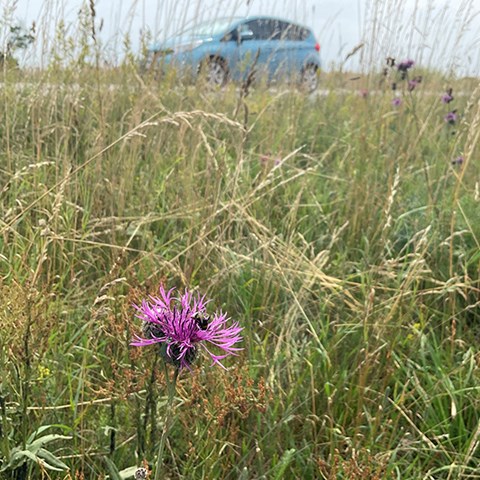Roadside bees and butterflies are affected by both current traffic and historic landscapes

Roadside verges and power line corridors can become vital habitats for butterflies, bumblebees, and plants, according to Svenja Horstmann´s thesis from the Swedish University of Agricultural Sciences. However, the biodiversity of these areas depends not only on their current state but also on their history. Along older roads, there were more plant species, and bumblebee diversity was richer in landscapes that historically featured abundant pastures and meadows.
In Sweden, over 90 percent of pastures and meadows have disappeared in the past century. This dramatic transformation has left pollinators with fewer flower-rich areas and suitable nesting sites. This makes it crucial to study how roadside verges and power line corridors can serve these species.
Taking a journey through time, Svenja Horstmann examined how history has influenced roadside verges and power line corridors in Uppsala, Stockholm, Södermanland, and Västmanland counties. Using maps from various periods and aerial photographs, she looked back up to 100 years in time and surveyed plants, bumblebees, and butterflies in the field.
They found 121 plant species, including 70 specialized grassland species, 49 butterfly species (22 grassland specialists), and 18 bumblebee species.
Interestingly, biodiversity was influenced not only by current habitat conditions but also by history.
Older roadside verges had higher plant species richness, while the number of bumblebee species in verges was linked to the amount of pastures and meadows present in the landscape during the 1950s. In older power line corridors, there were more grassland-specialist plant species.
“This shows that it takes time for species to colonize suitable habitats. It’s therefore important to consider both historical and current landscapes when planning management, such as deciding which verges and corridors to prioritize,” Svenja Horstmann explained.
Her dissertation included several studies, mainly focusing on roadside verges. She also looked at how traffic and mowing regimes affect flower-visiting insects in southernmost Sweden. “During my work in Skane, I found around 40 percent of the regionally occurring butterfly and wild bee species, even though the study only covered 0.0004 percent of the study region. And among them were also red-listed species. That’s pretty cool.”
One key conclusion is that verges hold potential as habitats for species from pastures and meadows. This is promising, considering that roadside verges cover 56,000 square kilometers in Europe—an area equivalent to the size of Croatia.
Management practices that promote floral diversity lead to more wild bees and butterflies in the richest verges. However, traffic poses a challenge. Vibrations, noise, and pollution from passing vehicles can create an inhospitable environment, and insects are at risk of being hit by cars.
“One of my most important findings is that the more heavily trafficked a road is, the more dangerous the environment becomes for wild bees and butterflies. However, wider road verges can mitigate some of the negative effects,” Svenja Horstmann said.
Another significant point in her dissertation is that pollinators need not just flowers but also nesting sites. Many wild bees require cavities in dead wood, plant stems, or stone walls.
“Adding nesting sites is a way to benefit pollinators. Of course, it’s also a safety issue, but in the widest verges, which can be over 10 meters wide, it should be possible.
Read more
The impact of traffic, management and landscape on flower-visiting insects and plants in road verges
